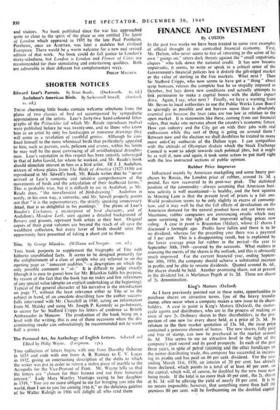London Calling
London Is London. Edited by D. M. Low. (Chatto and Windus.
los. 6d.) Flower of Cities—A Book of London. (Max Parrish. r 8s. 6d.)
A RESOUNDING poem written by William Dunbar in 1501 is the first of Mr. D. M. Low's 283 prose and verse extracts. The same
poem gives a title to Messrs. Parrish's collection of original studies of twenty-two aspects of London life, all written by different authors. Mr. Low's anthology is strung on the thread of a unique quality which he calls " Londinity." The word is deplorable, but the editor is successful in his object of showing that an enduring and endearing quality of " Londinity " can be found reflected as
unmistakably in the literature of the fifteenth century as it is in that of the twentieth. The anonymous editor of Flower of Cities has sought " to do full justice to the sum of London's many- sidedness." This aim was too ambitious, but a rare sense of quality is-evident in many of the essays of which the book is composed.
Mr. Low, in his anthology, has eschewed, for the most part, all foreigners' impressions, deliberate attempts at analysis or historical retrospects. He has culled a large number of his choicest flowers from unfamiliar fields. He has found the quality he sought in unselfconscious and artless pieces, and has very sensibly admitted an element of caprice. The collection is arranged in a loose chronological order, and is not arbitrarily divided into topics. He has used a severe and catholic standard of selection, and the result is admirable. The centuries flow easily through his pages, and the transitions are unforced. The development of London outwards is shown, as well as a number of minor currents of change within the town's established quarters. This anthology lives and wears an air of distinction. It is vertebrate, and justifies the title which its compiler has chosen.
Thirty-two drawings by Mr. Edward Bawden garnish Mr. Low's collection. This artist has also illustrated Mr. John Betjeman's
prankish and inimitable article on London's railway stations which is, appropriately, the first study in Flower of Cities. Mr. Bawden's drawings are pleasing, but it may be suggested that he is even happier with buildings than he is with human figures. Flower of Cities is divided into three parts. The first deals with history and institutions ; the second with a number of residential
districts ; the third with arts and .amenities, including the B.B.C.
Where so much is good and charming, it may seem invidious to single out of the team particular writers or artists for special praise. There is excellent written and pictorial matter in this beautifully produced book to suit all tastes, and every reader will have his preference. On a first reading Mr. Christopher Sykes on London's palaces and parks, Miss Stevie Smith on a London suburb, and Mrs. (Jacquetta) Hawkes on museums seemed remarkably' lively. topical, and stimulating. Mr. Sykes's and Mrs. Hawkes's articles are both illustrated by splendid photographs in full colour.
Flower of Cities contains twelve full-page plates in colour, twenty- four full-page illustrations in monochrome, and a large number of drawings by accomplished artists including John Minton, Leona Rosoman, Ronald Stade, and Keith Vaughan. Where the ma chrome illustrations arc reproductions of old prints the sou details should have been given.
London changes so constantly that there is no reason why peo should ever cease to write books about it. There is room for hex such as these which seek to interpret its spirit to its inhabit,'
and visitors. No book published since the war has approached quite so close to the spirit of the place as one entitled The Spirit of London which appeared in 1935 by the late Paul Portheim. Portheim, once an Austrian, was later a stateless but civilised European. There would be a warm welcome for a new and revised edition of that work. No book could do full justice to London's many-sidedness. but London is London and Flower of Cities are recommended for their stimulating and entertaining qualities. Both are admirable in their different but complementary ways.
PHILIP MAGNUS.































 Previous page
Previous page